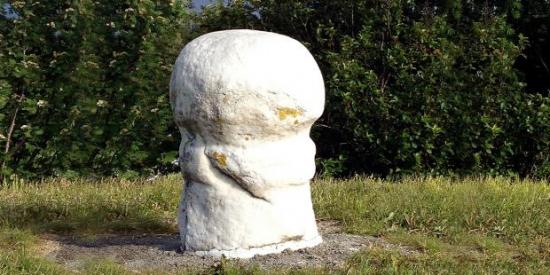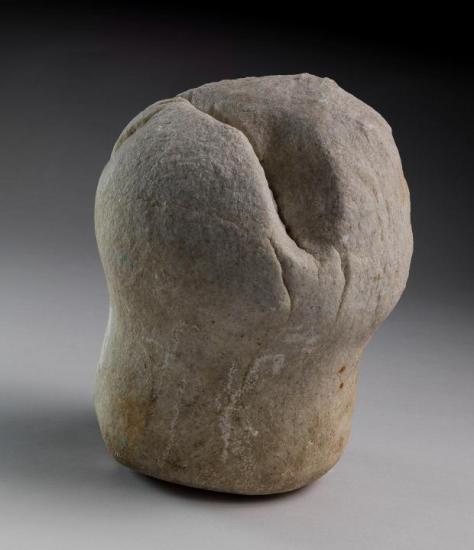Fertility cults were common throughout Europe in pre-Christian times, and Norway also still has signs of them
Aud Beverfjord / NTNU Trondheim - Norwegian University of Science and Technology
Source - http://sciencenordic.com/stone-phalluses-and-ancient-fertility-cults

This marble phallus is found in Dønna municipality on the Helgeland coast. It originated from the migration period, and is probably over 1,600 years old. (Photo: Nina Tveter, NTNU)
Close to one hundred stone phalluses have been found in Norway. They are symbolic representations of the penis, representing male potency and fertility.
Animal and human sacrifices made to a symbolic phallus were thought to ensure a successful new crop among people, animals and nature.
Ancient fertility rituals have survived in modified form into the modern era.
Elven sacrifice “alveblot”
The pagan sacrificial ritual and harvest festival held at the winter solstice in the old Norse month of Ýlir was also the time for the alveblot, or sacrifices to the elves.
Elves played a central role in pagan cult ceremonies. They belonged to the Norse pantheon, but were closer to people’s earthly life than the gods. The elves embodied both fertility and death powers.
Elf cult ceremonies were usually local and happened within each household, but they were also celebrated officially at certain times of the year, such as at the winter solstice on December 21st. At this time of year nature lay dormant, and this was therefore a feast for the dead, but it also looked ahead with hope toward a fertile year for people and livestock.
In the skaldic poem Austfararviser (“East Journey Verses”) King Olav Haraldsson’s court poet Sigvat Tordarson tells the story of how he once was refused entry to a home where the alveblot celebration was well underway. Strangers were not welcomed. Sigvat describes a woman’s voice shouting: “Do not come closer, you godless wretch. I fear Odin’s wrath, we worship the ancient gods!” The woman was preparing for the alveblot, during which the phallus played a meaningful role.
We know little about how the original rituals took place in the Nordic regions, but texts and images from Mediterranean countries show how parts of this cult were performed. Soil fertility and the rebirth of nature were personified through dance and sacred drama, as in the myth of Persephone, where her mother Demeter looks for her daughter who has been abducted to Hades. Myths such as this symbolize birth, death and rebirth of vegetation.
The fertility god Priapus
A Greek myth explains the background to phallus worship: Aphrodite, the goddess of love, gave birth to a child, the glorious deity Priapus. The father’s identity was uncertain, but Zeus himself was suspected by his wife Hera.

Bone knife with runes found in a grave in Fløksand in northern Hordaland county, Norway. The inscription reads: lina laukaRa. In ancient folklore onion was a protection against disease and spells. The runes on the blade were probably spoken in a phallic ritual. (Illustration: NIæR, Norges Innskrifter med de ældre Runer (Inscriptions in the Elder Futhark))
With a magical touch of her stomach, Aphrodite cursed the child that grew there. That led to the child, Priapus, being born ugly, with a huge body and a giant, permanent erection.
Aphrodite was so repulsed by the obscenity of this creature that she threw him out of her kingdom and abandoned him in the wilderness.
Here Priapus was taken in by a shepherd who saw that wherever this creature walked, everything grew vigorously. Plants sprang up from the ground and the animals jumped on each other, mated violently and multiplied. Priapus soon became known and worshiped as a fertility god.
The story of Völsa
The Scandinavian story of Völsa þáttr (þáttr, ‘short story’) paints a vivid picture of how a phallic ritual was performed.
The story was recorded in the 1380s. The action took place in 1029 and shows that pagan tradition was still alive. The story revolves around a severed horse penis named Völsi (“phallus”) that is the focal point in the ritual.
The Völsa tale tells about an old man and an old woman who lived with their son and daughter on a promontory far from other people. A slave and a slave woman also lived on the farm.
When the slave had slaughtered the horse and was about to discard the penis, the son came by. He took the penis to his mother, who was sitting with his sister and their slave woman.
The boy teased the slave woman that “the member would not be boring between her legs”, and the slave woman laughed. That this was not completely accepted is indicated by the reaction of the daughter, who asked her brother to get rid of the penis.
But the mother, described as a great song woman, kept it and thought it would be useful. She packed it into a linen kerchief along with onions and herbs to preserve it. Every night the woman took the horse penis out of the wooden box, and the whole household took part in a ceremony where she recited a rhyme, gave the penis to her husband who did the same, and then on to the next person until all had taken part in the ritual.
Female graves

Stone phallus in white marble found at Kvernes stave church in Averøy in Møre og Romsdal county, Norway. (Photo: Åge Hojem, NTNU University Museum)
Wrapping of the penis in linen and onion is a known ancient tradition. A meat knife from the 300s CE, found in a woman’s grave in Fløksand in northern Hordaland county, has a runic inscription which reads: lina laukaR(a) ‘flax onions’. Lauk is also known from other Old Scandinavian inscriptions.
For example, it appears on a gold bracteate (a flat, thin, single-sided embossed metal plate worn as jewelry) from Skrydstrup in southern Denmark. Another one, from Skåne in southern Sweden, was deciphered by Sophus Bugge: “You have become powerful, Volse! and (now) taken up (out of the coffin), furnished (as you are) with linen and propped up with onion. M–receive this offering, but you, farmer, take hold of Volse!”
Several stone phalluses have been found on or in female graves. We may ask what role a male fertility symbol plays in a woman’s grave? The answer may be that stone phalluses had more of a general fertility role, where the main interest was not a physical sexual act, but rather encompassed all growth in nature. And the Völsa tale, where the lady of the house led the ritual, may indicate that women had a leading role in the phallic cult.
But how can we explain the more peripheral stone phalluses that were not connected to graves, house sites or ancient shrines? These locations may indicate that people held annual processions, bearing their fertility symbols through the agricultural landscape—a blessing round where stone phalluses were carried around to bring a good year and peace.
Holy stones
The word “phallus” has its origins in the Greek phallos. The word was later adopted in many modern languages and refers to the more common word penis. Objects that visually resemble a penis or act as a symbol for it are more correctly referred to as having a “phallic” shape.
The phenomenon of “sacred stones” can possibly be traced back to the stone at Bethel, which is mentioned in the Bible. It is linked to the Canaanite god Baal and the story of Jacob, who was resting his head on a rock there when he saw a vision of a ladder to heaven.
Sacred stones were perceived as a connection between the human world and that of the gods, and were thus regarded as shrines.
Archaeologically, this group of finds goes by the name “sacred white stones.” Most are made of white quartz or marble. These stones have been associated with burial sites, where several of them have been found, while others do not seem to have been associated with a grave.
Nevertheless, we assume that they were an important part of a cult, where they played a central role in the rituals related to fertility cultivation. Several of the phallic stones are found at churches and ancient church sites. This suggests that the rocks represent a continuous location for worship, where a pagan cult existed before the place continued as a church.
PART.2